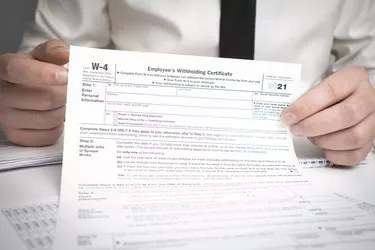
New hires across the U.S. are often presented with a stack of documents to read and complete at orientation time. These include agreements to anti-harassment policies, health insurance enrollment forms and various security clearances. Accompanying all this documentation are I-9 and W-4 forms.
The W-4 is an IRS record that helps the hiring company calculate how much income tax to withhold from each paycheck. The I-9 is published by the U.S. Department of Homeland Security (DHS) and is used to confirm that the new employee is legally eligible to hold the job. Proper execution of these forms can optimize the new employee's tax liability.
Video of the Day
Video of the Day
How you complete the W-4 impacts your monthly cash flow.
How W-4s Affect Tax Returns
Otherwise known as the Employee's Withholding Certificate, the W-4 form, as completed by a company hire, tells the human resources department how much compensation should set aside to meet the employee's tax obligations to the federal and state governments. Revised in 2018, Form W-4 accomplishes this task by obtaining information about filing status, income sources apart from the company, number of dependents and anticipated deductions.
The precision with which the employee enters this data can make affect whether the taxpayer gets a refund or must pony up more funds to satisfy their tax obligation. At least, accuracy on the W-4 can keep the tax obligation relatively modest. Caution is advised because underpaying taxes during the year will not only leave you shouldering the difference come April 15, but can also lead to penalties.
Of course, the converse is also true. How you complete the W-4 impacts your monthly cash flow. If money is tight, the employee may wish to claim as many deductions as possible up front, allowing for a fatter paycheck every two weeks. In any event, the simpler your situation, the easier it is to be precise.
A single person with only one job and no other income runs little risk of making an error on the W-4. If, on the other hand, the employee has a second job, a spouse who works, three kids and a side hustle that yields extra cash, they need to be particularly meticulous when filling out the W-4.
Form I-9 and Taxes
The I-9 document verifies identity and citizenship/immigration status so the employer can comply with federal law. To be clear, information on the I-9 comes from DHS, not the IRS. It is intended to determine eligibility to work in the U.S. rather than to calculate a tax burden.
It goes without saying that all U.S. citizens pass this threshold of qualification. Noncitizens should have an immigration status that permits them to work. The U.S. Citizenship and Immigration Services (USCIS) agency of DHS issues temporary and permanent work authorizations to successful applicants.
How does the I-9 affect taxes? If the I-9 indicates residency status, the employee is taxed in the same manner as a citizen. To hold lawful permanent residency, one must possess a Permanent Resident Card issued by USCIS, commonly know as a "green" card. This means the individual has received permission to reside in the U.S. contingent on good behavior, including paying their taxes.
Alternatively, tax residency status is ascertained by the Substantial Presence Test: The person must reside in the U.S for at least 31 days of the current year and 183 days over the last three years. Those holding temporary work visas, by contrast, are not assessed payroll taxes and do not pay into Medicare or Social Security.